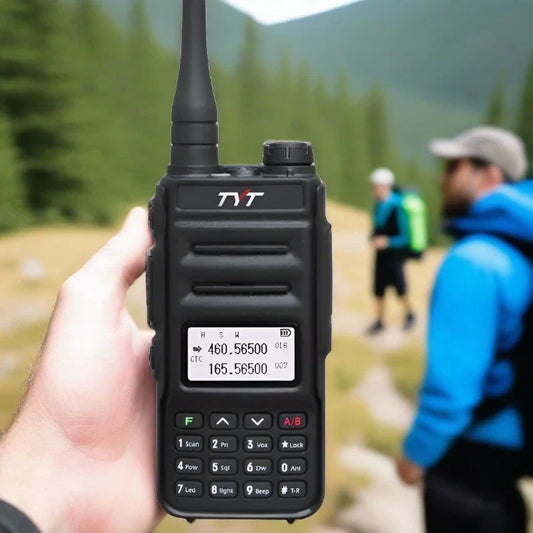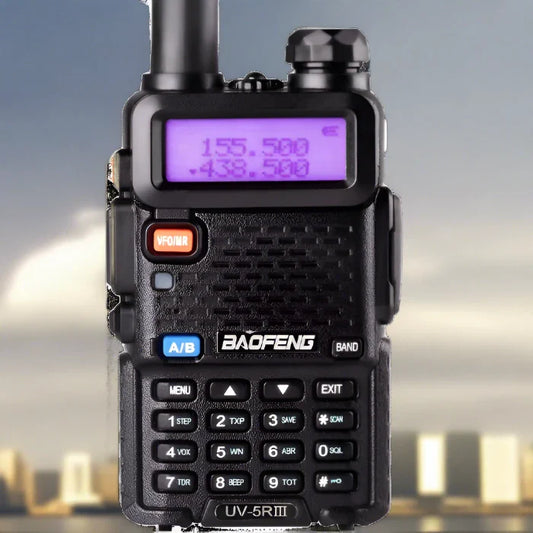A SWR (short for “standing wave ratio”) meter is a calibration tool used to measure the standing wave ratio of a two way radio, a type of short-distance radio system that allows users to communicate over a limited number of channels. Amateur Ham Radio and CB Radio are good examples of consumer radios that should be tested for SWR. Knowing how to find your radio's SWR value is important, as it allows you to adjust the antenna for optimal reception. To run a test, simply connect your radio’s coaxial and antenna cables to the indicated ports on the meter. When you set the meter for calibration and activate the radio transmitter, you’ll see a number indicating the strength of the signal being broadcasted. SWR is typically only tested on mobile or base installations.
SHOP SWR METERS AND TEST EQUIPMENT HERE
Hooking up Your SWR Meter:
Conduct your test at least 20 feet (6.1 m) from any nearby structures. In order to get the most reliable reading possible, you’ll need to make sure that there’s nothing that might block the radio signal from getting to your antenna. If there are tall buildings, trees, or similar obstructions around, you may end up with a reading that doesn’t accurately reflect your radio’s current calibration.
The best place to operate an SWR meter is in a clear, open area, such as a parking lot or field.
Ask anyone in your immediate vicinity to stand a minimum of 20 feet (6.1 m) away from your radio. If they’re crowding the antenna, they could get in the way of the outgoing signal.
Warning: Avoid testing your radio in a garage, carport, or other enclosed space where the surrounding walls may have a distorting effect.
Disconnect the antenna and coaxial cables from your radio. A standard coaxial cable is a thick black cord with a screw-on barrel head. Antenna cables tend to be slightly thinner, and may be designed to attach to a separate external antenna piece. You’ll find both of these components plugged into the back of the radio. To remove them, simply unscrew them and pull them free from their respective ports. Your radio's main component cables may look very similar, so be sure to keep up with which is which if they’re not labelled. Since your SWR meter is designed to test whether the antenna is correctly calibrated to send and receive signals, it needs to go between your radio’s transmitter and antenna.
Connect your radio’s coaxial cable to the transmitter port on your meter. This port will be located either on the side or back of a standard SWR meter. It should be marked “transmitter” or “XMIT.” Insert the prong of the coaxial cable into the hole at the center of the port, then rotate the barrel head clockwise until it's cinched down firmly. The coaxial cable for a CB radio is sometimes referred to as a “jumper lead.” Keep this in mind if you're following along with your radio's owner's manual. If your SWR meter includes its own built-in connectors, you’ll need to connect your cable leads to them instead.
Run your radio’s antenna cable to the antenna port on the SWR meter. Like the transmitter port, your meter’s antenna port should be labelled either “antenna” or “ANT.” Connect the antenna lead from the radio to the corresponding meter port the same way you did the coaxial cable, then take a moment to make sure it’s secure. Double-check that both leads are configured for the correct ports before you continue. If they’re not, the readings you get back will be skewed and unhelpful.
Taking a Reading:
Locate the power button or switch on a digital meter to activate the unit. Most newer SWR meters feature a central power button on the face of the device. On some models, you may find a power switch on the side or back of the unit's casing. Your meter’s display screen will light up when you turn it on. If you’re working with an analogue meter that doesn’t have a power button, make sure that the “Function” switch is toggled to the “FWD” position to start with. Some meters may have a position "CAL", Measuring the forward power is also used to Calibrate the meter. If you happen to press a wrong button on your digital meter by accident, you can restore the device’s default settings at any time by switching it off and back on again. Some SWR meters will also test RF Power. Ensure that the function of the meter is set to "SWR"
Turn the calibration dial on analogue meters all the way counter clockwise. You must set analogue meters for calibration manually. To do this, find the dial marked “Calibration” and rotate it in a clockwise direction. Now key up the radio and produce an audible tone into the microphone. For an Amateur Radio station identify with your call sign and then say testing followed by a count. As CB does not require call-sign identification some will say "Auuuuuuuudio" or "Raaaaaaadio" Slowly start turning the calibration clockwise until the meter is in the "SET" position on the SWR meter. Typically this will be at the end of the measurement markings on the right side. It is not necessary to exceed the markings or "ping" the needle, just to the end of the SWR markings. Un-key the microphone and catch your breath. Once you’ve set your meter, it will be primed to provide a reading with the flip of a switch.
Set your radio to channel 20. Turn the channel dial on the radio interface to the left, or press and hold the down arrow button under the display until you reach channel 20. This is the centre frequency on a CB radio, and the place where you’ll begin your measurements. Later on, you’ll also be checking channel 1 & 40, the upper and lower frequencies. The idea is to gauge the antenna’s average signal strength by taking a reading from both ends of the radio’s frequency range. For an amateur radio start at the bottom of the band and work your way up. If you are testing the 2M band most will often test at 146.000 MHz as that is in the middle of the band. For the 70CM band 440.000 MHz is a good place to start.
When ready to test the SWR flip the switch from the FWD or CAL position to REF. You are now testing the reflected signal, or what is lost back to the radio when transmitting.
Press and hold the transmitter button on your radio’s hand microphone. “Keying” the hand mic, as it’s known in radio circles, activates the radio’s internal transmitter. This is the signal that your SWR meter will be measuring. Be sure to hold the button down the entire time that you’re conducting a reading. Newer SWR meters typically provide automatic readings as soon as you depress the transmitter button on your radio’s hand mic. When testing an amateur radio always identify your test with your issued callsign. For a CB station, strong mono tone audio into the mic.
Record the value shown the is the measured SWR for that channel. Write down this number for future reference. A reading of 1-1 indicates perfect signal strength. 1.5 is considered the benchmark for antenna manufactures. As long as the number you see is below 3 you are in the safe zone. Keep in mind 3 is considered high SWR and it is advisable to lower the SWR by either adjusting the antenna, improving the ground plane, or investigating any issues with the coax. A reading of 2 is satisfactory, but still high, and should be lowered if possible. Don’t release the transmitter button until you’ve made a note of the SWR value. The reading will disappear as soon as you let go.
Repeat the process on channel 1 and 40. Compare the three readings. The closer they are, the more stable the signal. Ideally, the numbers should be within a few decimal places of one another. Tip: It’s important to hold the microphone the same distance away from the transmitter and your mouth for each test. Ideally also produce the same audio tone for the readings. Even a small change of position could throw off subsequent measurements.
Make adjustments to your radio or antenna as needed. If you get back an SWR value greater than 3, it either means that your antenna is the wrong length for your radio or a short or grounding issue may be to blame. Often relocating the antenna mount, or re-routing the coax will help bring the SWR down. A mag mount for example will produce the best ground plane when in the middle of the trunk or roof. Ensure that extra coax is left loose. If there is extreme excess of cable consider using a smaller piece. If a smaller piece cannot be used create a choke by winding the cable in a neat circular fashion. While 45o or better angles may make the cable look nice, they can also attribute to an increase in SWR, if routing your coax through conduits in a vehicle ensure there are no sharp or tight bends.
Consult your owner’s manual to find solutions for common problems or, in the case of a mobile setup, take your vehicle to a qualified technician to have it worked on professionally.
Tuning an antenna involves cutting it to a length that’s more suitable for the frequency being used. This is a highly technical project that you shouldn't attempt without the necessary knowledge and experience. Also antennas may be designed for dual band or multi band operation, and knowing where the various antenna traps are for the frequency will be crucial to getting the right lengths of the various elements.
It may not be safe to operate your radio if it’s not calibrated properly. Transmitting at higher power levels can put stress on the final transistors and can cause loss of power or even failure of the amplifier in the radio.
Attribution: https://www.wikihow.com/Use-an-SWR-Meter









